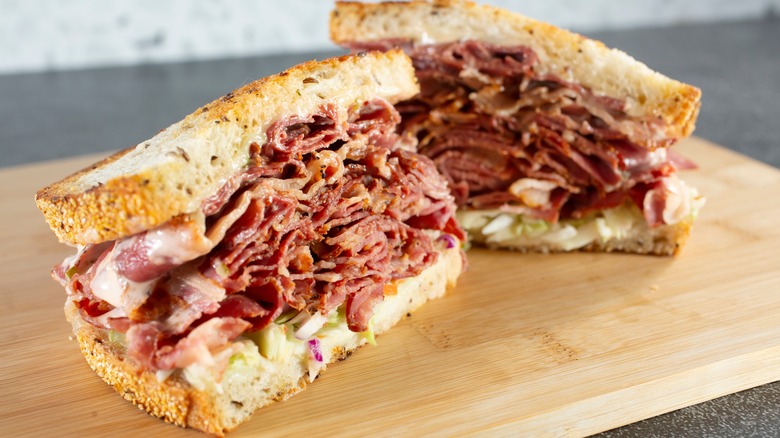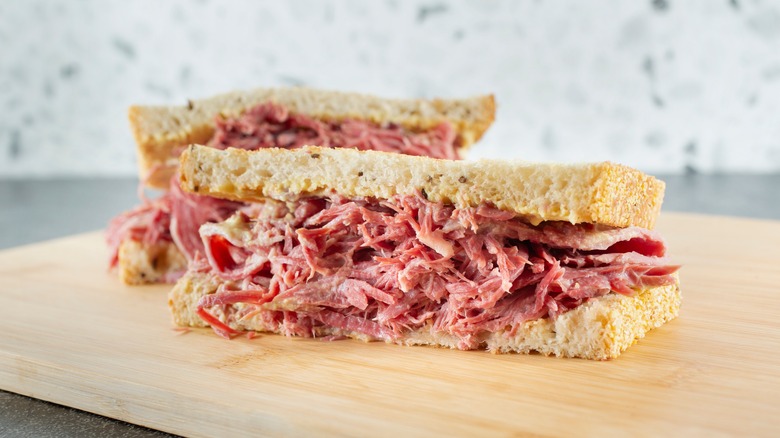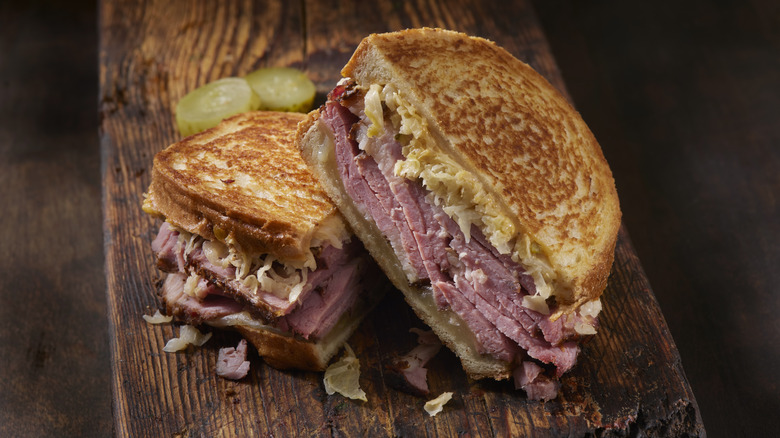Is There Even A Difference Between Corned Beef And Pastrami?
There are multiple differences between corned beef and pastrami ranging from their countries of origin to their preparation methods. While both found a home in delis and consist of beef, specifically brisket, these delicatessen cousins have several nuances that deliver equally unique and delicious flavors.
If you've eaten it before, you probably know that corn doesn't play a role in making corned beef. The dish originated in Ireland sometime in the 17th century (before the myth of the St. Patrick's Day corned beef dinner). The "corned" in corned beef likely stems from the Germanic word "kurnam" meaning "small seed." This refers to the rock salt used to preserve the beef as the mineral can look a bit like small seeds.
Like corned beef, pastrami also originated as a form of meat preservation but traveled from Turkey and then to Romania before arriving in America via Jewish-Romanian immigrants. The word "pastrami" underwent several evolutions, beginning as the Turkish word "pastirma" meaning "dried meat" and changing to "pastrama" in Romania before being changed, again, to "pastrame" in Yiddish by the Jewish-Romanian immigrants of the 19th century.
So while both foods have origins in practically preserving food before the invention of refrigeration, their differences began in their conceptions and continue to this day. Seeing them side by side illustrates their differences alone.
Similarities and differences in preparation and serving
A deli makes both corned beef and pastrami with brisket. However, delis prepare corned beef with the "flat" of a brisket, the rectangular lean portion of the cut, and pastrami with the point, the less symmetrical and more marbled section that lays over the flat. However, some delis make pastrami with a plate or navel cut, from behind and below the brisket, or the deckel, a much firmer shoulder cut.
Both meats begin by curing in a brine but afterward, the two diverge radically. Corned beef gets all of its flavor from the brine before being steamed or boiled. Pastrami, however, receives a thorough spice rub before being either steamed or smoked. Typically, delis regard pastrami as a much more labor-intensive meat but that doesn't mean you can't learn how to cure your own pastrami.
Both corned beef and pastrami can be found thinly sliced on sandwiches thanks to their shared immigrant history. In 19th century New York, where delis were first popularized, many immigrants were Irish or Jewish. Through cultural diffusion, the two peoples shared their foods until corned beef could be found right alongside pastrami at almost any deli.
In the same way delis adopted corned beef as a staple, eaters can also find pastrami prepared in different recipes like pastrami pizza or even a crunchy pastrami scotch egg. Both meats are highly versatile and have found new homes in different cultural dishes.
Differences in taste
Despite their similarities, corned beef and pastrami differ greatly in terms of flavor and texture. Because it's leaner and cooked for an overall shorter amount of time, corned beef is much firmer than the classic melt-in-your-mouth pastrami. The flavor of corned beef comes more from the quality of the beef and the brine used to make it — lending itself well to additional condiments and seasonings.
Much of pastrami's iconic flavor comes from its signature spice rub. While this varies from deli to deli, the sharp crack of peppercorns combines with the rich flavors from smoking to create a taste similar to American barbecue brisket. Pastrami is also brined, then cured, then smoked, with each successive preservation method adding layers of flavor until you're left with a rich, smoky, heavily spiced beef dish.
While both meats are firm enough to slice on sandwiches and tender enough to chop and fry up in a hash, their differences in taste give both meats plenty of room on the deli counter for customers to make their own choices.



